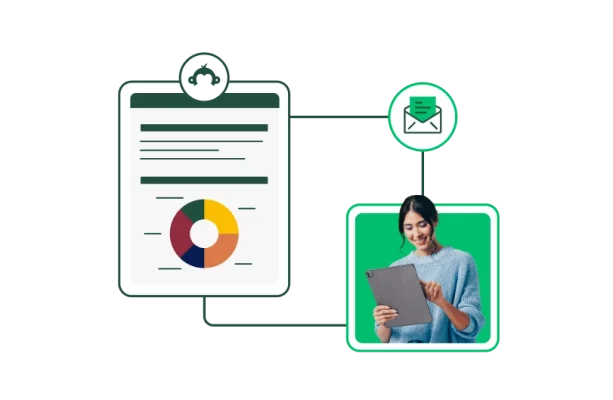Employee feedback forms: 100+ questions, answers, and templates

Employee feedback is a game-changer for any organization. When employees feel heard and appreciated, they’re more motivated, productive, and loyal.
A well-designed employee feedback form helps companies understand what works and what needs improvement from those who know best: the employees.
In this guide, we’ll explore the different types of employee feedback forms, why they’re important, and how to design forms that support a strong employee feedback loop.
What are employee feedback forms?
Employee feedback forms are surveys designed to gather insights and opinions from employees about their workplace experience.
Companies use these forms differently, from quick check-ins to detailed company culture and policy evaluations. Some conduct short, anonymous pulse surveys weekly, while others use more extensive annual reviews to guide long-term strategic planning.
HR pros use these forms to gain insights into employees' thoughts about their jobs, managers, and work environment. Regularly collecting feedback allows them to prevent or address employee experience (EX) gaps that lead to disengagement and high turnover.
Importance and benefits of employee feedback forms
Employee feedback forms can help companies improve job satisfaction and cultivate a positive work environment. Gather employee insights regularly to meet employee expectations and create a more dynamic and effective workplace.
- Increased employee engagement: Asking for feedback demonstrates that employees’ opinions are valued, leading to a stronger sense of connection with the organization. This engagement can boost morale and drive higher levels of motivation and commitment.
- Better identification of improvement areas: Feedback helps uncover hidden challenges, from inefficient workflows to management concerns. Addressing these issues early on allows companies to make adjustments for smoother operations.
- Enhanced professional development: Employees can offer valuable insights into what resources or training they need to improve. This feedback helps organizations create personalized development plans aligning with individual and business goals.
- Improved communication within the organization: Employee feedback promotes open dialogue between all levels of the organization, bridging communication gaps and encouraging transparency.
- Higher employee retention rates: Responding to feedback shows a commitment to employee satisfaction, reducing turnover, and boosting long-term loyalty.
- Boosted organizational performance: Feedback provides critical data to help companies make informed decisions that enhance efficiency and productivity.
- Fostered a culture of continuous improvement: Consistent feedback helps organizations adopt a mindset of ongoing growth and encourages innovation, ensuring the company stays agile in an ever-evolving market.
- Actionable insights for organizational change: Employee feedback reveals specific areas needing change, offering clear guidance for improvement.
Types of employee feedback forms
Employee feedback forms vary, capturing insights on workplace culture, job performance, and more. Knowing the types available helps you address various topics effectively, supporting informed decisions that drive improvement and growth.
Here are some common types of employee feedback forms and their use cases:
Performance evaluations
Performance evaluations assess how well employees meet job expectations, highlighting their achievements and growth areas. Collecting employee performance feedback also helps align employees with managers, leadership, and overall company goals.
Managers and HR teams usually conduct performance review cycles regularly to set future goals and build or adjust employee development plans. Aim to conduct a performance review quarterly or yearly to close gaps and monitor performance.
360-degree feedback
360-degree feedback reviews source feedback from multiple team members (including managers, peers, subordinates, and employees) to offer a holistic view of an individual’s performance.
Use this feedback to understand how employees interact with their teams and how they contribute to the overall work environment. Aim to conduct a 360-degree review yearly to support continuous improvement and ongoing employee development.
Employee satisfaction surveys
Employee satisfaction surveys measure how content employees are with their work environment, leadership, compensation, and more.
Send an employee satisfaction survey as a pulse check on employee morale and help organizations prioritize improvements that directly impact retention and productivity. Use feedback on employee satisfaction levels to address concerns about work culture and workflows before they escalate.
Employee Net Promoter Score® (eNPS) surveys
Employee Net Promoter Score tracks employee satisfaction and engagement by asking how likely employees are to recommend the company as a place to work. Responses to eNPS surveys can provide a useful mix of quantitative and qualitative data around employee sentiment.
Employee training feedback
Employee training feedback forms are used to evaluate the effectiveness of training programs, asking employees about the content, presentation, and relevance to their role. By collecting this feedback, companies can continuously improve their training initiatives to ensure that employees receive the knowledge and skills they need to succeed. These forms help refine training strategies to make them more engaging and impactful for the team.
Remote work feedback
As remote and hybrid work models become more common, feedback from remote workers provides valuable insights into how companies can better support their teams through technology, processes, or work flexibility.
108 employee feedback form questions
The following categories highlight key focus areas and offer a comprehensive set of questions to assess different aspects of the employee experience. Customize these questions to suit your organization's needs and help guide performance evaluations, self-assessments, and peer feedback.
Questions for employee self-evaluation
Self-assessment helps employees reflect on their performance, strengths, and career goals.
Self-assessment of performance
- What do you consider to be your most significant achievements this year?
- What challenges did you face in your role, and how did you overcome them?
- How do you prioritize your tasks, and do you feel your priorities align with the team’s objectives?
- Are there any areas in which you feel you could improve your performance?
- How well do you think you manage time and meet deadlines?
- What tools or resources have been most helpful to you in achieving your goals?
- How do you handle stress or pressure in your role?
- What feedback have you received from others that has helped you improve your performance?
- How do you ensure quality and accuracy in your work?
- In what areas would you like to see more support from your manager or colleagues?
- How do you assess your progress toward achieving your goals?
- What steps have you taken to develop professionally over the past year?
Skill development and training needs
- Are there any specific skills you feel you need to improve or develop further?
- What training programs or resources do you think would help you enhance your performance?
- How confident are you in your current skill set?
- What skills do you believe are essential for success in your role?
- Are there any skills outside your current role that you’d like to develop?
- How would you rate your current ability to adapt to new tools or technologies?
- Have you sought any learning opportunities this year? If so, what were they?
- What type of professional development would help you grow in your role?
- How do you prefer to learn new skills (e.g., formal training, mentorship, self-guided learning)?
- Is there a skill you’ve acquired recently that has significantly improved your performance?
- Do you feel you have access to the necessary resources to enhance your skills?
- What type of feedback do you prefer to receive to support your development?
Career aspirations
- What are your long-term career goals, and how do they align with your current role?
- What are you most passionate about in your current job?
- How do you see yourself growing within the company?
- What type of opportunities would you like to explore in the future?
- What areas of the business interest you the most, and why?
- What steps are you taking to align your current work with your career aspirations?
- Are there any roles or departments within the organization you would like to explore?
- How do you envision your professional growth in the next 1-3 years?
- What would make you feel more motivated to achieve your career goals?
- What kind of responsibilities would you like to take on in the future?
- How would you like to be supported in reaching your career aspirations?
- Do you have any specific role models or mentors who influence your career path?
Questions for managerial feedback
Managerial feedback provides insights into employee performance from a leadership perspective, helping identify strengths and areas for improvement.
Evaluating employee performance
- How would you rate the employee’s overall job performance this period?
- Does the employee meet the expectations of their role?
- How consistently does the employee deliver high-quality work?
- How well does the employee meet deadlines and manage their time?
- How does the employee contribute to the team’s objectives and goals?
- Does the employee proactively identify opportunities for improvement in their work?
- How effectively does the employee handle challenges or obstacles in their role?
- In what areas do you think the employee could improve their performance?
- How well does the employee communicate with you and other team members?
- How does the employee take feedback and apply it to their work?
- How well does the employee adapt to changes in work priorities or tasks?
- Does the employee demonstrate accountability for their work and actions?
Feedback on teamwork and collaboration
- How well does the employee collaborate with other team members?
- Does the employee encourage open communication within the team?
- How effectively does the employee resolve conflicts or disagreements with colleagues?
- Does the employee contribute to a positive and supportive team culture?
- How well does the employee work with others across different departments?
- Does the employee share knowledge and resources with the team?
- How open is the employee to feedback and suggestions from peers?
- How well does the employee balance independent work with collaborative efforts?
- Does the employee demonstrate respect and empathy for others in the team?
- How willing is the employee to help others when they need support?
- Does the employee actively participate in team meetings and discussions?
- How well does the employee handle team challenges or difficult situations?
Leadership and initiative
- Does the employee take initiative in their role and anticipate the needs of the team?
- How effectively does the employee lead by example?
- Does the employee motivate others to achieve team goals?
- How well does the employee handle responsibility and accountability?
- Does the employee provide clear guidance and direction when needed?
- How does the employee support the development of others on the team?
- Does the employee demonstrate effective decision-making skills?
- How well does the employee delegate tasks and responsibilities?
- Does the employee inspire others with their work ethic and attitude?
- How effectively does the employee manage team projects or tasks?
- Does the employee demonstrate problem-solving skills in leadership situations?
- How open is the employee to new ideas or approaches to leadership?
Questions for peer feedback
Peer feedback helps assess an employee's ability to work effectively with colleagues, contributing to a positive and productive team environment.
Interpersonal skills
- How would you describe the employee's communication style with peers?
- Does the employee listen actively during discussions?
- How effectively does the employee express their ideas to others?
- Does the employee show respect and consideration for other team members’ opinions?
- How well does the employee handle sensitive or difficult conversations?
- Does the employee maintain a positive attitude in team interactions?
- How well does the employee manage personal differences with colleagues?
- Is the employee approachable and open to conversation?
- Does the employee demonstrate empathy and understanding toward others?
- How well does the employee resolve interpersonal conflicts within the team?
- Does the employee encourage collaboration and mutual respect among team members?
- How effectively does the employee adapt their communication style to different personalities?
Reliability and dependability
- Can you rely on the employee to complete tasks on time?
- How consistently does the employee meet their commitments and responsibilities?
- How dependable is the employee in high-pressure situations?
- Does the employee follow through on promises and commitments?
- How effectively does the employee manage their workload and deadlines?
- Is the employee someone you can trust to handle tasks independently?
- How does the employee handle situations when things don’t go as planned?
- Does the employee consistently meet expectations without needing constant supervision?
- How accountable is the employee when mistakes are made?
- Does the employee consistently perform at a high standard?
- How often does the employee offer help or support to others?
- How well does the employee manage unexpected challenges or urgent tasks?
Contribution to team success
- How does the employee contribute to the team’s overall success?
- Does the employee offer creative solutions to team challenges?
- How well does the employee collaborate with others to achieve team goals?
- How effectively does the employee manage team projects or initiatives?
- How does the employee contribute to the team’s problem-solving efforts?
- Does the employee take ownership of team successes and challenges?
- How does the employee contribute to fostering a positive team dynamic?
- Is the employee willing to share knowledge or resources with colleagues?
- How effectively does the employee help others achieve team objectives?
- How often does the employee offer feedback or suggestions to improve team performance?
- How well does the employee balance individual performance with team goals?
- Does the employee inspire or motivate others to contribute to team success?
These 108 questions cover a range of feedback topics, exploring aspects of employee performance, development, and teamwork. Include them in your employee feedback form to encourage managers, peers, and employees to reflect on progress, close gaps, and support ongoing development.
Best practices for employee feedback forms
Use these best practices to craft forms that are easy to complete and yield valuable, actionable data:
1. Keep it concise
Employees are more likely to complete a form that respects their time and doesn’t overwhelm them with lengthy questions. Focusing on key areas encourages thoughtful, focused responses and gets the information you need without causing survey fatigue.
2. Use clear and straightforward language
Avoid jargon, technical terms, or convoluted phrasing. Clear, straightforward language ensures that every respondent interprets the questions the same way, leading to more consistent and actionable results.
3. Ensure anonymity
Anonymity is one of the best ways to encourage honest, open feedback. Employees may be more willing to share their true thoughts when they know their answers won’t be directly linked to them. Allow your team to provide constructive criticism without fear of repercussions, particularly for sensitive topics.
4 . Provide a mix of question types
Not all feedback is best captured in a single format. A mix of question types—such as multiple-choice for quick, quantifiable answers and open-ended questions for more detailed insights—helps you gather a well-rounded view of employee experiences.
5. Ask specific questions
Vague or overly general questions can lead to unclear or unhelpful answers. To get actionable feedback, ask questions that are specific and focused on areas where you need insight.
Narrowing down the scope of your questions ensures that responses are meaningful and give you the direction you need to make improvements.
6. Make it regular
Feedback shouldn’t be a one-time event. Consistently gathering input allows you to track trends over time and address emerging issues early. Regular feedback forms create an ongoing dialogue with your employees, helping you stay on top of their needs and concerns, and providing a clear view of progress in your initiatives.
7. Encourage constructive feedback
Creating an environment where employees feel comfortable offering constructive criticism is crucial for growth. Positive feedback is important, but it's the constructive suggestions that drive real change. By encouraging feedback that focuses on solutions and areas for improvement, you help employees feel empowered to contribute to the organization’s evolution.
8. Follow up on feedback
The most impactful feedback forms are those that lead to action. When employees see that their input is valued and that changes are being made as a result, it strengthens trust and engagement. Follow up on the feedback you receive by sharing what changes will be made and how their responses are being used to improve the workplace.
9 . Test and adjust
Feedback forms should evolve as your organization changes. Regularly testing and tweaking your forms ensures that they remain relevant and effective. Take the time to assess how well your feedback forms are working, and be open to making adjustments based on employee input and shifting company priorities.
Related reading: Creating an effective employee feedback culture
How to create effective employee feedback forms
Creating an effective employee feedback form requires careful planning and attention to detail. By following a structured approach, you can design forms that collect meaningful insights and drive organizational improvement. Here’s a step-by-step guide to help you create feedback forms that are both useful and engaging for your employees.
1. Define your objectives
Before you begin designing your feedback form, it’s essential to define the purpose behind it. What do you want to learn? Are you focusing on performance, job satisfaction, team dynamics, or something else?
Clearly identifying the objectives will guide your question selection and ensure that the feedback you gather is relevant to your goals. Whether you want to improve employee engagement or identify training needs, a clear objective will help you stay focused and get actionable insights.
2. Choose the right feedback form type
The type of feedback form you use should align with your objectives. If you’re evaluating employee performance, a performance evaluation form is appropriate. For gauging overall satisfaction, an employee satisfaction survey may be more fitting.
Depending on your needs, you might also consider a 360-degree feedback form, peer review, or engagement survey. Each type offers different insights, so choosing the right one is crucial for collecting the data you need.
3. Decide on the question format
Different question types yield different insights. A balanced combination of question formats is ideal for getting both quantitative and qualitative feedback. Consider using:
- Multiple-choice questions for straightforward, quantifiable data.
- Likert scale questions for measuring attitudes or opinions on a scale.
- Open-ended questions for in-depth responses that provide context or personal opinions.
4. Create specific, actionable questions
Avoid vague or overly broad questions. Instead, ask questions that are specific, clear, and easy to understand. The more focused your questions are, the more actionable the responses will be.
For example, instead of asking, “Are you happy with your job?” ask, “What aspects of your job do you enjoy most, and what areas do you think could be improved?” Tailoring your questions in this way will help you pinpoint areas for improvement or recognize strengths.
5. Use question banks for inspiration
Crafting the right questions can be challenging, but using a question bank can save you time and effort. Question banks provide a collection of pre-written, customizable questions that are designed to gather the most relevant and valuable feedback.
6. Test your form
Before sending your feedback form out to the entire organization, test it with a small group of employees. This trial run will help identify any confusing or time-consuming areas, and you can make adjustments based on their input. Testing ensures that your final version is clear, effective, and easy to complete.
7. Implement and collect feedback
Once you’ve finalized your feedback form, distribute it to employees and set a clear timeline for when responses should be submitted. Be sure to communicate the form's purpose and what you plan to do with the feedback you collect. This transparency helps build trust and encourages participation.
8. Analyze the results
After collecting responses, take time to analyze the results. Look for trends, common themes, and any areas that require immediate attention. Break down both quantitative data and qualitative feedback to get a comprehensive understanding of what employees are experiencing.
9. Act on the feedback
The most important part of the feedback process is taking action. Use the insights you’ve gained to make informed decisions that improve the work environment, address concerns, and recognize successes.
Following these steps can help you create feedback forms that gather valuable data and foster an open, communicative workplace culture.
Improve employee engagement with SurveyMonkey
Use employee feedback forms to improve workplace culture, increase engagement, and drive organizational success. Sending feedback forms regularly fosters an environment where employees feel heard, valued, and motivated to contribute to the company’s goals.
Start improving employee engagement today with SurveyMonkey employee performance management tools, or choose from a variety of pre-made survey templates like the employee feedback survey templates or 360-Degree Employee Evaluation Survey Template to get started.
NPS, Net Promoter & Net Promoter Score are registered trademarks of Satmetrix Systems, Inc., Bain & Company and Fred Reichheld.
Discover more resources

HR toolkit: Make employee experience your competitive advantage
HR leaders can use this toolkit to help drive exceptional employee experiences.

State of Surveys: Top trends and best practices for 2025
Watch this webinar to explore 2025 survey trends, mobile insights, and best practices for optimizing your survey strategy.

How Americans feel about the Costco DEI policy: 25+ stats and 10 tips
68% of Americans back Costco’s DEI commitment. Explore 25+ stats on public sentiment around Costco, DEI policies, and the anti-DEI movement.

How to get more out of your employee engagement surveys
Learn how to design, analyze, and apply employee engagement surveys to drive meaningful change and improve workplace culture.